
Niger–Congo is a hypothetical language family spoken over the majority of sub-Saharan Africa. It unites the Mande languages, the Atlantic–Congo languages, and possibly several smaller groups of languages that are difficult to classify. If valid, Niger–Congo would be the world's largest in terms of member languages, the third-largest in terms of speakers, and Africa's largest in terms of geographical area. It is generally considered to be the world's largest language family in terms of the number of distinct languages, just ahead of Austronesian, although this is complicated by the ambiguity about what constitutes a distinct language; the number of named Niger–Congo languages listed by Ethnologue is 1,540.

Benue–Congo is a major branch of the Volta-Congo languages which covers most of Sub-Saharan Africa.
Bikya is a potentially extinct Southern Bantoid language spoken in Cameroon. It is one of the three, or four, Furu languages. In 1986 four surviving speakers were identified, although only one spoke the language fluently.

Southern Bantoid is a branch of the Bantoid language family. It consists of the Bantu languages along with several small branches and isolates of eastern Nigeria and west-central Cameroon. Since the Bantu languages are spoken across most of Sub-Saharan Africa, Southern Bantoid comprises 643 languages as counted by Ethnologue, though many of these are mutually intelligible.

Bantoid is a major branch of the Benue–Congo language family. It consists of the Northern Bantoid languages and the Southern Bantoid languages, a division which also includes the Bantu languages that constitute the overwhelming majority and after which Bantoid is named.
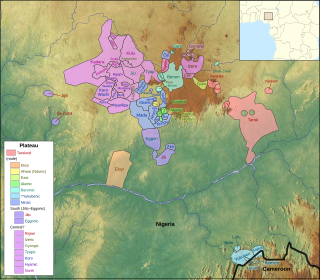
The forty or so Plateau languages are a tentative group of Benue–Congo languages spoken by 15 million people on the Jos Plateau, Southern Kaduna, Nasarawa State and in adjacent areas in central Nigeria.

There are over 525 native languages spoken in Nigeria. The official language and most widely spoken lingua franca is English, which was the language of Colonial Nigeria. Nigerian Pidgin – an English-based creole – is spoken by over 60 million people.

The Beboid languages are any of several groups of languages spoken principally in southwest Cameroon, although two languages are spoken over the border in Nigeria. They are probably not most closely related to each other. The Eastern Beboid languages may be most closely related to the Tivoid and Momo groups, though some of the geographical Western Beboid grouping may be closer to Ekoid and Bantu.

The Ekoid languages are a dialect cluster of Southern Bantoid languages spoken principally in southeastern Nigeria and in adjacent regions of Cameroon. They have long been associated with the Bantu languages, without their status being precisely defined. Crabb (1969) remains the major monograph on these languages, although regrettably, Part II, which was to contain grammatical analyses, was never published. Crabb also reviews the literature on Ekoid up to the date of publication.
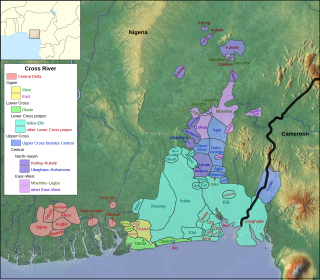
The Cross River or Delta–Cross languages are a branch of the Benue–Congo language family spoken in south-easternmost Nigeria, with some speakers in south-westernmost Cameroon. The branch was first formulated by Joseph Greenberg; it is one of the few of his branches of Niger–Congo that has withstood the test of time.
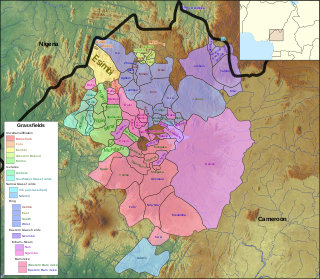
The Grassfields languages are a branch of the Southern Bantoid languages spoken in the Western High Plateau of Cameroon and some parts of Taraba state, Nigeria. Better known Grassfields languages include the Eastern Grassfields languages, Bamun, Yamba, Bali, and Bafut and the Ring languages, Kom, Nso, and Oku. Almost all of these languages are closely related, sharing approximately half of their vocabulary.
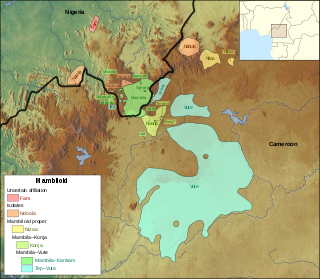
The twelve Mambiloid languages are languages spoken by the Mambila and related peoples mostly in eastern Nigeria and in Cameroon. In Nigeria the largest group is Mambila. In Cameroon the largest group is Vute.
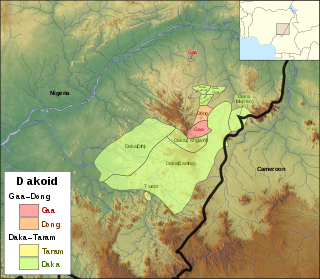
The Dakoid languages are a branch of the Northern Bantoid languages spoken in Taraba and Adamawa states of eastern Nigeria.
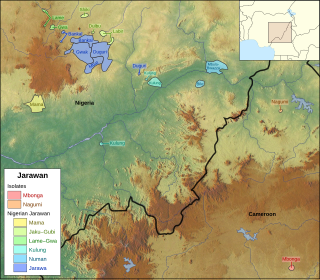
Not to be confused with Jarawa, a language spoken primarily in India.
Daka is one of two languages spoken by the Chamba people in Nigeria, the other being Chamba Leko.
Mbe is a language spoken by the Mbube people of the Ogoja, Cross River State region of Nigeria, numbering about 65,000 people in 2011. As the closest relative of the Ekoid family of the Southern Bantoid languages, Mbe is fairly close to the Bantu languages. It is tonal and has a typical Niger–Congo noun-class system.
The Jagham language, Ejagham, also known as Ekoi, is an Ekoid language of Nigeria and Cameroon spoken by the Ekoi people. The E- in Ejagham represents the class prefix for "language", analogous to the Bantu ki- in KiSwahili
Bokyi is a regionally important Bendi language spoken by the Bokyi people of northern Cross River State, Nigeria. It is ranked amongst the first fifteen languages of the about 520 living languages in Nigeria, with a few thousand speakers in Cameroon.
Dong, or Donga, is a poorly documented language in Nigeria. Though clearly Niger–Congo, it is difficult to classify; British linguist Roger Blench proposes that it is one of the Dakoid languages, the closest to Gaa.
Northern Bantoid is a branch of the Bantoid languages. It consists of the Mambiloid, Dakoid, and Tikar languages of eastern Nigeria and west-central Cameroon.













